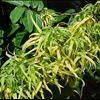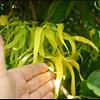This plant may be available to buy
Click the banana to see

|
Ylang-Ylang click pic to enlarge |
|
Zone 10 Native to Southern India, Java, Malaysia, the Philippines and other Pacific islands, the Ylang-Ylang tree, Cananga odorata, is the true Chanel No.5 Perfume Tree. It's common name is Ylang-Ylang, can be pronounced (ee-lang ee-lang) and is among the most celebrated flowering trees in the world Made famous by Coco Chanel who in 1923 said upon introducing Chanel No.5 in Paris, "I wanted a perfume that is composed - not hints of roses or lilies of the valley. A woman's perfume - redolent, evocative of a woman. A perfume unlike any other ever made. The ideal scent for a woman." So is Ylang-Ylang like Chanel No.5 or is Chanel No.5 perfume like the scent of this tree? Except for the alcohol and added power of its oils, the perfume smell to your nose is nearly identical to the Ylang-Ylang tree. Ylang-Ylang's famous blossoms are now used in many other types of perfumes as well click pic to enlarge Perhaps the only rival to this perfume tree is the JOY Perfume tree, Michele champaca Ylang-Ylang blooms when very young. Its flowers are carried in mass clusters at the end of its elegant drooping branches click pic to enlarge Each flower is a beautiful five-point star which begins as white, then green, then turning a rich, golden yellow as the blossoms mature. Trees can be 30-40 feet tall This tree blooms with tropical abandon. We have observed specimens bloom a minimum of two times a year - typically in June/July/August and near December. Mature specimens are known to bloom almost continuously all year long click pic to enlarge Ylang-Ylang grows with no particular requirements of soil, water or food. Normal moderate care after establishment is all that is needed In spite of all these wonderful features, Ylang-Ylang is rarely seen in South Florida and very difficult and expensive to buy. The only ones we are aware of in Broward County, we planted |



